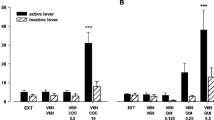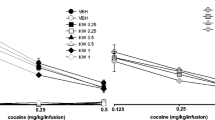Abstract
Effects of the (-)- and (+)-isomers of N6-(phenylisopropyl)-adenosine (PIA) were studied in rats trained to respond under fixed-interval and fixed-ratio schedules of food reinforcement. Both isomers of PIA decreased response rates; however, the (-)-isomer decreased response rates at doses as low as 0.1 μM/kg and was 100–300 times more potent than the (+)-isomer. The potency differences suggest that the effects observed were due to actions at A1-adenosine receptors. Caffeine, an adenosine-receptor antagonist, when administered alone in doses of 10–154 μM/kg, increased response rates under the fixed-interval schedule and did not affect rates of responding under the fixed-ratio schedule. Higher doses decreased response rates under both schedules. Caffeine shifted the (-)-PIA dose-effect curve to the right. At a low dose of caffeine (25.7 μM/kg), which alone modestly increased response rates under the 5-min fixed-interval schedule, the disruptions in rates and patterns of responding produced by (-)-PIA were restored to resemble control performances. The higher dose of caffeine (77.2 μM/kg), which alone produced larger increases in rates of responding under the fixed-interval schedule, restored overall response rates to control levels when administered in combination with (-)-PIA. However, patterns of responding after the combination of doses remained disrupted. These effects suggest that some of the behavioral effects of caffeine are a result of mechanisms other than adenosine-receptor blockade.
Similar content being viewed by others
References
Ando K (1975) Profile of drug effects on temporally spaced responding in rats. Pharmacol Biochem Behav 3:833–841
Bruns RF, Daly JW, Snyder SH (1980) Adenosine receptors in brain membranes: Binding of N6-cyclohexyl[3H]adenosine and 1,3-diethyl-8-[3H]-phenylxanthine. Proc Natl Acad Sci 77:5547–5551
Clark FC, Steele BJ (1966) Effects of d-amphetamine on performance under a multiple schedule in the rat. Psychopharmacologia 9:157–169
Coffin VL, Carney JM (1983) Behavioral pharmacology of adenosine analogs. In: Daly JW, Kuroda Y, Phillis JW, Shimizu H, Ui M (eds) Physiology and pharmacology of adenosine. Raven Press, New York, pp 267–273
Daly JW (1982) Adenosine receptors: Targets for future drugs. J Med Chem 25:197–207
Daly JW, Bruns RF, Snyder SH (1981) Adenosine receptors in the central nervous system: Relationship to the central actions of methylxanthines. Life Sci 28:2083–2097
Davis TRA, Kensler CJ, Dews PB (1973) Comparison of behavioral effects of nicotine, d-amphetamine, caffeine and dimethylheptyl tetrahydrocannabinol in squirrel monkeys. Psychopharmacologia 32:51–65
Dunwiddie TV, Worth T (1982) Sedative and anticonvulsant effects of adenosine analogs in mouse and rat. J Pharmacol Exp Ther 220:70–76
Fredholm BB, Hedqvist P (1979) Presynaptic inhibition of transmitter release by adenosine and its antagonism by theophylline. In: Langer SZ, Starke K, Dubocovich ML (eds) Presynaptic receptors. Pergamon Press, Oxford, pp 281–286
Glowa JR, Spealman RD (1984) Behavioral effects of caffeine, N6-(l-phenylisopropyl) adenosine and their combination in the squirrel monkey. J Pharmacol Exp Ther 231:665–670
Gollub LR (1964) The relations among measures of performance on fixed-interval schedules. J Exp Anal Behav 7:337–343
Haulica I, Ababei L, Branisteanu D, Topoliceanu F (1973) Preliminary data on the possible hypnogenic role of adenosine. J Neurochem 21:1019–1020
Katims JJ, Annau Z, Snyder SH (1983) Interactions in the behavioral effects of methylxanthines and adenosine derivatives. J Pharmacol Exp Ther 227:167–173
Katz JL (1982) Rate-dependent effects of d- and l-amphetamine on schedule-controlled responding in pigeons and squirrel monkeys. Neuropharmacology 21:235–242
Katz JL (1984) Effects of clonidine and some α-adrenergic antagonists alone and in combination on schedule-controlled behavior in pigeons and mice. Psychopharmacology 83:38–43
Londos C, Cooper DMF, Wolff J (1980) Subclasses of adenosine receptors. Proc Natl Acad Sci 77:2251–2554
McKim WA (1980) The effect of caffeine, theophylline and amphetamine on operant responding of the mouse. Psychopharmacology 68:135–138
McMillan DE (1968) Some interactions between sympathomimetic amines and amine-depleting agents on the schedule-controlled behavior of the pigeon and the squirrel monkey. J Pharmacol Exp Ther 163:172–187
Maitre M, Ciesielski L, Lehmann A, Kempf E, Mandel P (1974) Protective effect of adenosine and nicotinamide against audiogenic seizure. Biochem Pharmacol 23:2807–2816
Meliska CJ, Brown RE (1982) Effects of caffeine on schedule-controlled responding in the rat. Pharmacol Biochem Behav 16:745–750
Phillis JW, Edstrom JP, Kostopoulos GK, Kirkpatrick JR (1979) Effects of adenosine and adenine nucleotides on synaptic transmission in the cerebral cortex. Can J Physiol Pharmacol 57:1289–1312
Sattin A, Rall TW (1970) The effect of adenosine and adenine nucleotides on the cyclic adenosine 3′, 5′-phosphate content of guinea pig cerebral cortex slices. Mol Pharmacol 6:13–23
Sirochman V, Carney JM (1981) Behavioral pharmacology of adenosine analogs. Fed Proc 40:294
Smellie FW, Daly JW, Dunwiddie TV, Hoffer BJ (1979) The dextro and levorotatory isomers of N-phenylisopropyladenosine: Stereospecific effects on cyclic AMP-formation and evoked synaptic responses in brain slices. Life Sci 25:1739–1748
Snyder SH, Katims JJ, Annau Z, Bruns RF, Daly JW (1981) Adenosine receptors and behavioral actions of methylxanthines. Proc Natl Acad Sci 78:3260–3264
Spencer DG, Lal H (1984) Discriminative stimulus properties of l-phenylisopropyladenosine: Blockade by caffeine and generalization to 2-chloroadenosine. Life Sci 32:2329–2333
Vaillant GE (1964) Antagonism between physostigmine and atropine on the behavior of the pigeon. Naunyn-Schmiedeberg's Arch Exp Path Pharmakol 248:406–416
Van Calker D, Muller M, Hamprecht B (1978) Adenosine inhibits the accumulation of cyclic AMP in cultured brain cells. Nature 276:839–841
Vapaatalo H, Onken D, Neuvonen PJ, Westermann E (1975) Stereospecificity in some central and circulatory effects of phenylisopropyl-adenosine (PIA). Arzneimittel-Forsch 25:407–409
Wayner MJ, Jolicoeur FB, Rondeau DB, Barone FC (1976) Effects of acute and chronic administration of caffeine on schedule dependent and schedule induced behavior. Pharmacol Biochem Behav 5:343–348
Webb D, Levine TE (1978) Effects of caffeine on DRL performance in the mouse. Pharmacol Biochem Behav 9:7–10
Author information
Authors and Affiliations
Rights and permissions
About this article
Cite this article
Goldberg, S.R., Prada, J.A. & Katz, J.L. Stereoselective behavioral effects of N6-phenylisopropyl-adenosine and antagonism by caffeine. Psychopharmacology 87, 272–277 (1985). https://doi.org/10.1007/BF00432706
Received:
Accepted:
Issue Date:
DOI: https://doi.org/10.1007/BF00432706




